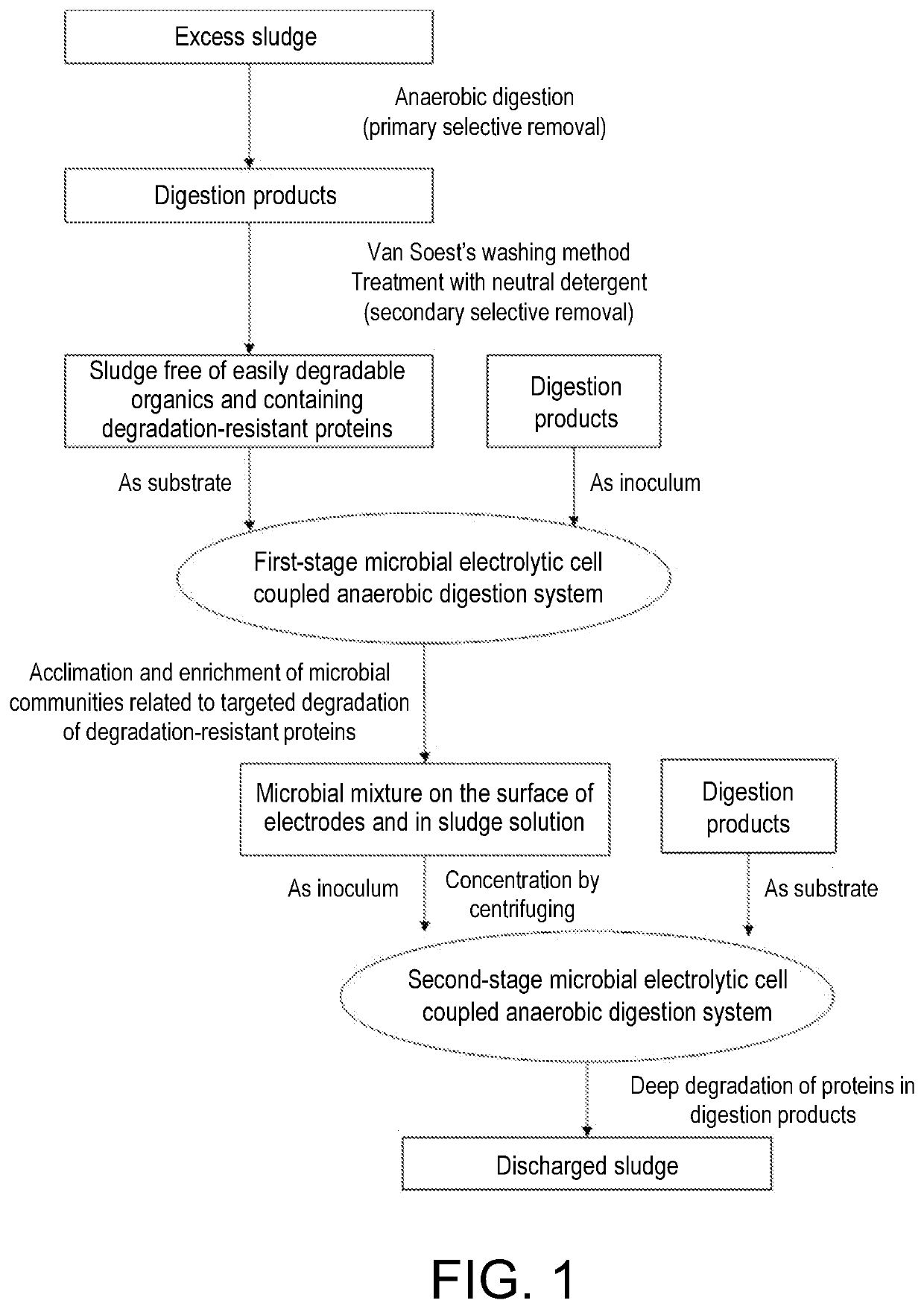Method for enhancing deep degradation of proteins in sludge
a technology of protein degradation and deep degradation, which is applied in the direction of biological sludge treatment, specific water treatment objectives, waste based fuel, etc., to achieve the effects of reducing the total methane production of excess sludge, enhancing deep degradation of proteins, and reducing the amount of sludg
- Summary
- Abstract
- Description
- Claims
- Application Information
AI Technical Summary
Benefits of technology
Problems solved by technology
Method used
Image
Examples
example 1
[0042]A method for enhancing deep degradation of proteins in sludge by using a microbial electrolytic cell coupled anaerobic digestion system, as shown in FIG. 1, including the following steps:
[0043](1) Preparation of neutral detergent of Van Soest's washing method: 18.6 g of sodium ethylenediamine tetraacetate (EDTA, analytical grade) and 6.8 g of sodium borate (Na2B4O7.10H2O) were weighed and put into a beaker, and a small amount of distilled water was added thereto; after heating for dissolution, 30 g of sodium lauryl sulfate (C12H25NaO4S) and 10 ml of 2-ethoxyethanol (C4H10O2, analytical grade) were added; then, 4.56 g of anhydrous disodium hydrogen phosphate (Na2HPO4) was accurately weighed and placed into a separate beaker, a small amount of distilled water was added thereto, the mixture was slightly heated to dissolve, transferred to the previous beaker, and made up to 1000 ml;
[0044](2) Excess sludge from the sewage plant was used, wherein the proportion by mass of volatile s...
example 2
[0048]A method for enhancing deep degradation of proteins in sludge by using a microbial electrolytic cell coupled anaerobic digestion system, as shown in FIG. 1, including the following steps:
[0049](1) Preparation of neutral detergent of Van Soest's washing method: 18.6 g of sodium ethylenediamine tetraacetate (EDTA, analytical grade) and 6.8 g of sodium borate (Na2B4O7.10H2O) were weighed and put into a beaker, and a small amount of distilled water was added thereto; after heating for dissolution, 30 g of sodium lauryl sulfate (C12H25NaO4S) and 10 ml of 2-ethoxyethanol (C4H10O2, analytical grade) were added; then, 4.56 g of anhydrous disodium hydrogen phosphate (Na2HPO4) was accurately weighed and placed into a separate beaker, a small amount of distilled water was added thereto, the mixture was slightly heated to dissolve, transferred to the previous beaker, and made up to 1000 ml;
[0050](2) Excess sludge from the sewage plant was used, wherein the proportion by mass of volatile s...
example 3
[0054]A method for enhancing deep degradation of proteins in sludge by using a microbial electrolytic cell coupled anaerobic digestion system, as shown in FIG. 1, including the following steps:
[0055](1) Preparation of neutral detergent of Van Soest's washing method: 18.6 g of sodium ethylenediamine tetraacetate (EDTA, analytical grade) and 6.8 g of sodium borate (Na2B4O7.10H2O) were weighed and put into a beaker, and a small amount of distilled water was added thereto; after heating for dissolution, 30 g of sodium lauryl sulfate (C12H25NaO4S) and 10 ml of 2-ethoxyethanol (C4H10O2, analytical grade) were added; then, 4.56 g of anhydrous disodium hydrogen phosphate (Na2HPO4) was accurately weighed and placed into a separate beaker, a small amount of distilled water was added thereto, the mixture was slightly heated to dissolve, transferred to the previous beaker, and made up to 1000 ml;
[0056](2) Excess sludge from the sewage plant was used, wherein the proportion by mass of volatile s...
PUM
 Login to View More
Login to View More Abstract
Description
Claims
Application Information
 Login to View More
Login to View More - R&D
- Intellectual Property
- Life Sciences
- Materials
- Tech Scout
- Unparalleled Data Quality
- Higher Quality Content
- 60% Fewer Hallucinations
Browse by: Latest US Patents, China's latest patents, Technical Efficacy Thesaurus, Application Domain, Technology Topic, Popular Technical Reports.
© 2025 PatSnap. All rights reserved.Legal|Privacy policy|Modern Slavery Act Transparency Statement|Sitemap|About US| Contact US: help@patsnap.com

